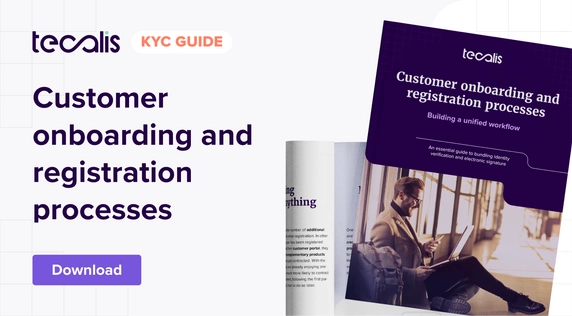Index
Get the latest news right in your inbox
The insurance sector is undoubtedly one of the most relevant industries today and the insurance policy is the central element of its activity. Without this document, it would not be possible to sign the contracts that give users peace of mind about their homes, businesses, vehicles and even their care and health.
The details of an insurance policy will define everything: coverages, price, conditions, dates... On the other hand, all policy elements must be well verified with anti-fraud controls by law, especially those that allow the policyholder, insured, insurer and beneficiary to be reliably identified.
We will review the parts of an insurance policy, its types and how they are now electronically linked to the contracts made by insurers, brokers and agents to obtain full legal support and have all the documentation digitized.
What is an insurance policy
An insurance policy is a document defining the conditions under which an insurer assumes the risk of an insured. It specifies the general, particular or special rules that will govern the insurance contract. If this document is not executed, the contractual relationship is non-existent and must be accepted by all parties and binding upon signature.
The most relevant part of the insurance contract is the policy, as we could analyze in the complete article on all the formal details of the contract. In it, data such as the insurable interest, the insurable risk, the premium and the obligations are indicated. They are the basic principles of the purpose of the insurance, specifying the object, exclusions, forms of settlement, etc.
It certifies the validity of the contract and its form generally corresponds to the type of insurance to be contracted. Both the policy and the premium payments act as a legally valid proof for the execution of the benefits and obligations under the insurance contract. This must be done in accordance with contract signature standards such as those set forth in the eIDAS electronic signature regulations.
In addition, AML anti-fraud checks and a customer due diligence process must be performed prior to policy issuance to comply with insurance contract law and standards such as AML6.
Elements and parts of a policy

Insurance policies must include a series of minimum and truthful information to be considered as such. The general and particular conditions attach elements in relation to the risk in an individualized manner (it cannot be done in a generic manner, as specified by law) and this information must be correct and verified:
- Full name, surname or company name and address of the legal or natural persons involved in the insurance policy. Specification of the policyholder, beneficiary, insured and company, with the types of products offered.
- The concept of the insurance and its link to the contract, with all the detailed particulars and with a breakdown by element.
- Purpose of the insurance, both for individuals (e.g. life, accident, etc.) and for tangible property (vehicles, real estate, assets, etc.).
- Specifications on types of risks and their nature that are covered in the insurance policy. Those that are not included will not be compensated in the indemnity if the event occurs.
- Warranties, exclusions and limitations.
- Payments to be paid as premium by the insured.
- Effective times and insurance expiration conditions. Electronic time stamps are often inserted when these processes occur.
- The total amount broken down by insured, the form of payment and how the indemnity will be paid for each risk.
- Service provision models in the case of an insurance contract of this type.
- Information about the mediator (brokerage companies, etc.) if any.
- Sections and annexes on applicable legislation, data protection, etc.
On the other hand, there are special conditions, which qualify what has already been defined by adding rules and clauses associated with the specific type of insurance. Here it is defined whether the insurance is franchised or not, the limitations, conditions related to the exclusive nature of a less common risk, etc.
Types of insurance policies and examples
As we have seen previously and in other articles, there are as many types of policies as the nature of the risk to be insured. And thanks to the new use cases enabled by RegTech technologies, we find more and more. We are going to summarize it in the 20 types of policies most used by the industry and the most relevant concepts:
- Combined or multi-peril policy: Provides coverage for different risks related to each other. Also known as umbrella policy.
- Base policy: Initial document in a group or floater policy, to which specific applications are added at a later date.
- Open or floating policy: This insurance contract provides flexibility to the insured by allowing for adjustments according to circumstances.
- All-risk policy: Guarantees jointly and simultaneously all risks that may affect the insured object, as in automobile insurance.
- Collective, group or accumulative policy: Covers several insured persons simultaneously, as opposed to the individual policy.
- Individual policy: Covers a single insured person, as opposed to a group policy.
- Worldwide-coverage policy: Extends its effects to all countries.
- Loss-making policy: It experiences claims whose amounts exceed the premiums collected.
- Policy in suspension of guarantees: Temporarily becomes void due to specific circumstances, such as non-payment of a bill.
- Estimated policy: Refers to insurance at estimated value.
- Released or settled policy: Exonerates the insured from the payment of premiums under certain conditions.
- Master policy: Single contract issued to an employer, with individual certificates for the members of the group.
- In quo vis policy: In marine transportation insurance, it does not designate a specific vessel.
- Policy in force: Indicates that an insurance contract is active, as opposed to a canceled policy.
- Policy replaced: It is canceled by the issuance of a new one but remains as a historical record with the client.
- Policy reinstated: It recovers its validity after a period of suspension.
- Renewed policy: Non-renewable, issued at the expiration of a temporary policy.
- Single policy: To distinguish it from the combined policy, it covers a single specific guarantee.
- Temporary policy: Its coverage is limited to a pre-established period of time, generally less than two years. When it is an insurance policy subscribed for less than 11 months, extending the period of an existing policy, it is known as a stub policy.
- Bearer policy: Insures the person who legitimately owns it. These, however, have fallen completely into disuse; previously, those that did identify as opposed to these were known as "nominative policy".
This formal classification of insurance policies allows insurance professionals to organize and understand them, ensuring a successful work according to the needs of each insurance and client. In the insurance agent portals, they have a list of active policies (in force), renewed, suspended, etc. and can, at a glance and with total security, make all kinds of arrangements thanks to these professional software.


Insurance policy number: a frequently asked question in the industry
Among the frequently asked questions about policies, we find that some users (both professionals and clients) sometimes find it difficult to easily locate the number of their managed insurance policy or policies.
Thanks to the development of digital tools for the insurance sector, driven by the emergence of InsurTech a few decades ago, we now have systems and customer areas that allow access to data stored in the insurance company.
To find out the number of your insurance policy, you must log into the platform and consult the contract or any premium payment statement. For professionals, they can enter the customer's ID number in their agent and branch front office or use many other methods provided by their Customer Hub.
Electronic signature: minute-lasting digital insurance policies
The introduction of electronic signatures in the insurance industry has marked a significant milestone in the speed and efficiency of insurance policy issuance. Electronic signatures allow policies to be created quickly and securely, eliminating the need for manual processes and paper. This method, backed by the eIDAS electronic signature regulation, offers a legally valid alternative to the traditional signature, guaranteeing the authenticity and integrity of documents in a way that is greater than a paper signature.
The benefits of using electronic signatures in the issuance of policies are manifold. First, it streamlines the process, allowing policyholders to obtain coverage in a matter of minutes, rather than days. In addition, it improves the customer experience by eliminating the need for face-to-face paperwork and tedious paperwork. The electronic signature also provides strong legal backing, as it meets the security and authentication standards required by insurance contract law.
Automatic document generation with IA GPT is now possible thanks to disruptive electronic signature tools. By entering all relevant data, you can ask the wizard to organize and draft most of the contract and policy. This has enabled industry professionals to be more efficient and correct errors.
An important aspect is the collection of documentation. In due diligence processes, processing time is extended by weeks for the verification of these documents such as payroll, tax receipts, identity documents, property records, etc. Thanks to second generation RegTech technologies, these documents can be validated and collected by a QTSP (Qualified Trust Service Provider) in minutes and in an automated way from any device without the mandatory need of a professional scanner and validating staff. With assured notarial support, electronic signature technologies include dozens of functionalities to solve all kinds of use cases related to insurance policies.
Electronic signature technology integrates seamlessly into existing systems of insurers, brokers and agents, facilitating a smooth transition to a more digital and advanced environment. By adopting this solution, the insurance industry optimizes its processes, reduces operational costs and aligns with growing user expectations in terms of security, simplicity and speed.

Notifications and electronic contracting in insurance contracts
Electronic notification and certified communications have revolutionized the way insurance contracts are managed and signed, as well as facilitating a key record of all notices and notifications through physical and digital channels, which is crucial in the industry. These advances enable high speed policy issuance, as identity verification and information gathering are automated and digital. Users appreciate this and are more willing to sign up.
For less digitized users, there are still dozens of advantages of electronic underwriting. Even if an agent assists with the entire underwriting process and performs the formalities from his Customer Hub, he can now activate insurance instantly in compliance with regulations thanks to these systems.
KYC (Know Your Customer) onboarding streamlines the process by electronically and securely collecting the necessary customer information, ensuring compliance with legal and regulatory requirements. Data is extracted from documents rather than the agent or customer typing everything in. This, combined with electronic notification and certified communication, ensures secure and documented communication between all parties involved in the insurance contract. And most importantly, in accordance with the regulations in force in each market and country, as these technologies are adapted depending on where they are being used.

E-contracting allows policies to take effect instantly once the process is completed, providing policyholders with immediate coverage. This approach not only simplifies administration, but also improves customer satisfaction by providing a seamless experience.
In short, the combination of signature, notifications and e-contracting is transforming the insurance industry, making it more agile, efficient and aligned with user expectations. These solutions not only offer operational benefits, but also significantly improve the customer experience in insurance contracting and enable the emergence of new business models and verticals as we have seen in the most recent insurance news.
























